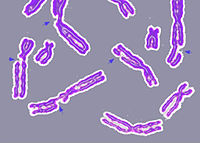
Photo from wikipedia
Exposure to lead in environmental and occupational settings continues to be a serious public health problem. At environmentally relevant doses, two mechanisms may underlie lead exposition-induced genotoxicity, disruption of the… Click to show full abstract
Exposure to lead in environmental and occupational settings continues to be a serious public health problem. At environmentally relevant doses, two mechanisms may underlie lead exposition-induced genotoxicity, disruption of the redox balance and an interference with DNA repair systems. The aim of the study was to evaluate the ability of lead exposition to induce impaired function of Ape1 and its impact on DNA repair capacity of workers chronically exposed to lead in a battery recycling plant. Our study included 53 participants, 37 lead exposed workers and 16 non-lead exposed workers. Lead intoxication was characterized by high blood lead concentration, high lipid peroxidation and low activity of delta-aminolevulinic acid dehydratase (δ-ALAD). Relevantly, we found a loss of DNA repair capacity related with down-regulation of a set of specific DNA repair genes, showing specifically, for the first time, the role of Ape1 down regulation at transcriptional and protein levels in workers exposed to lead. Additionally, using a functional assay we found an impaired function of Ape1 that correlates with high blood lead concentration and lipid peroxidation. Taken together, these data suggest that occupational exposure to lead could decrease DNA repair capacity, inhibiting the function of Ape1, as well other repair genes through the regulation of the ZF-transcription factor, promoting the genomic instability.
Journal Title: International Journal of Environmental Research and Public Health
Year Published: 2022
Link to full text (if available)
Share on Social Media: Sign Up to like & get
recommendations!